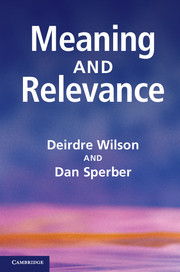Book contents
- Frontmatter
- Contents
- Figures
- Tables
- Preface
- Acknowledgements
- 1 Introduction
- Part I Relevance and Meaning
- Part II Explicit and Implicit Communication
- Part III Cross-Disciplinary Themes
- 12 Pragmatics, modularity and mindreading
- 13 Testing the cognitive and communicative principles of relevance
- 14 The why and how of experimental pragmatics
- 15 A pragmatic perspective on the evolution of language
- Notes
- References
- Index
15 - A pragmatic perspective on the evolution of language
Published online by Cambridge University Press: 05 June 2012
- Frontmatter
- Contents
- Figures
- Tables
- Preface
- Acknowledgements
- 1 Introduction
- Part I Relevance and Meaning
- Part II Explicit and Implicit Communication
- Part III Cross-Disciplinary Themes
- 12 Pragmatics, modularity and mindreading
- 13 Testing the cognitive and communicative principles of relevance
- 14 The why and how of experimental pragmatics
- 15 A pragmatic perspective on the evolution of language
- Notes
- References
- Index
Summary
Introduction
Suppose you overhear someone of whom you know nothing say, ‘It was too slow’. You have no problem understanding the sentence, but how much does that help you understand what the speaker means in uttering it? Very little. You don’t know what the pronoun ‘it’ refers to, what time span is indicated by this use of past tense ‘was’, and from what point of view ‘it’ was ‘too slow’. The speaker might have uttered this sentence in order to convey an indefinite variety of meanings: for example, that the chemical reaction in the lab that afternoon had been too slow compared to what she had expected, that the decrease in unemployment had been too slow in France when Jospin was Prime Minister to help him win the presidential election, or that Jack’s car was too slow (so that, last weekend, they had borrowed Peter’s).
‘It was too slow’ is an ordinary sentence. Most – arguably all – sentences in any human language likewise underdetermine their interpretation. The grammar of a language, even if it is taken to include not only syntax but also phonology and semantics, does not on its own provide a sufficient basis for understanding utterances. In understanding an utterance, humans do not just associate a linguistic meaning to the sound of a sentence: they also use information about the speech situation, the interlocutors, their past interactions, the background knowledge they share, and so on. Without this contextualisation, an utterance provides only fragments of meaning without a definite import.
- Type
- Chapter
- Information
- Meaning and Relevance , pp. 331 - 338Publisher: Cambridge University PressPrint publication year: 2012
- 7
- Cited by

